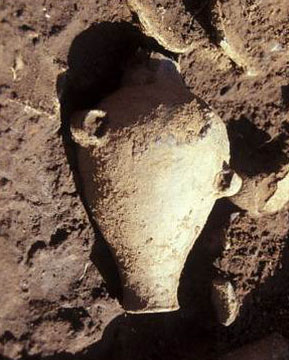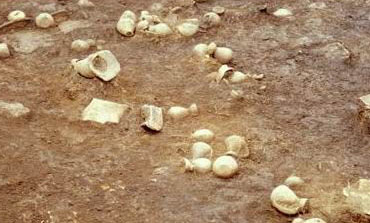The Relics of Yeshishan Mountain in Ludian County, Zhaotong
Chinese Name:鲁甸县野石山遗址
English Name: The Relics of Yeshishan Mountain in Ludian County, Zhaotong
Yeshishan Site, Ludian County
The Yeshishan Site is located in Yeshicun, Taoyuan Township, Ludian County, Yunnan Province, and dates back to between 1300 BC and 900 BC. This site, situated in Puzhilu Village of Taoyuan Township, was discovered during a cultural relics survey in 1982. The site covers an area of 52,500 square meters and is bordered by Caohai Lake to the east. Artifacts unearthed from the Yeshishan Site include pottery items such as single-handle pots, jars, long-necked spouted fragments, and large earthen jar pieces. The pottery materials include polished black pottery, gray pottery, sand-tempered gray pottery, and red pottery. The name of the site, “Puzhilu,” means “place where ancestors or ‘Pu’ people lived” in the Yi language, making it a valuable location for research into Yi ethnic history. It has been designated as a provincial-level key cultural relic protection site.
Overview of the Site
The Yeshishan Site is located in Yeshicun, Taoyuan Township, Ludian County, Yunnan Province, covering an area of about 1 square kilometer. Archaeological excavations were conducted from April to June 2002, covering an excavation area of 425 square meters.
Archaeological Findings
The excavation uncovered one pottery kiln, two ash pits, along with traces of fire pits, shallow trenches, and a few post holes. Over 300 relatively complete pottery artifacts and a large number of pottery fragments were unearthed, along with several stone and a few bronze artifacts. The pottery items include jars, basins, bowls, pots, bottles, cups, ewers, lids, spindle whorls, and long-necked spouted vessels. Stone tools found include adzes, axes, arrowheads, spindle whorls, and double-hole knives, while bronze items include awls and adzes. The site dates back to between 1300 BC and 900 BC.
Significance and Value
The Yeshishan Site represents a relatively independent stage in the development of Bronze Age culture in northeastern Yunnan and northwestern Guizhou.
Exploration
Overview of the Exploration Process
On March 1, 2010, Longteng Exploration Company from Shaanxi Province dispatched a team of nine archaeologists to Ludian to conduct a detailed archaeological survey of the Yeshishan Site. Based on the natural topography of Yeshishan, the stratigraphic deposits were roughly divided into three areas: west, central, and east. The exploration began on March 1, 2010, and fieldwork concluded on March 28. By April 1, the team transitioned to compiling indoor reports and producing drawings. The exploration covered an area of 54,000 square meters, revealing 84 different types of relics, including 35 house foundations, 21 ash pits, 11 areas of ash deposits, 3 ash ditches, 1 dried-up well, 1 tomb, and 12 living pits.
Exploration Results
The results of the exploration revealed that Yeshishan is home to a large area of ancient cultural relics. The cultural deposits are relatively thick, rich in content, clearly structured, and well-preserved. The extensive distribution of ash deposits is concentrated, thick, and rich in relics, containing a large amount of plant ash and pottery fragments. The discovered house foundations are all semi-subterranean structures, densely distributed with distinct patterns. The various types of relics identified during the exploration provide important materials and evidence for cultural research in this region. Additionally, these findings are of great significance for studying the historical development, evolution, and cultural trends of northeastern Yunnan and northwestern Guizhou.

 7 Days GolfingTour
7 Days GolfingTour
 8 Days Group Tour
8 Days Group Tour
 8 Days Yunnan Tour
8 Days Yunnan Tour
 7 Days Shangri La Hiking
7 Days Shangri La Hiking
 11 Days Yunnan Tour
11 Days Yunnan Tour
 6 Days Yuanyang Terraces
6 Days Yuanyang Terraces
 11 Days Yunnan Tour
11 Days Yunnan Tour
 8 Days South Yunnan
8 Days South Yunnan
 7 Days Tea Tour
7 Days Tea Tour
 8 Days Muslim Tour
8 Days Muslim Tour
 12 Days Self-Driving
12 Days Self-Driving
 4 Days Haba Climbing
4 Days Haba Climbing
 Tiger Leaping Gorge
Tiger Leaping Gorge
 Stone Forest
Stone Forest
 Yunnan-Tibet
Yunnan-Tibet
 Hani Rice Terraces
Hani Rice Terraces
 Kunming
Kunming
 Lijiang
Lijiang
 Shangri-la
Shangri-la
 Dali
Dali
 XishuangBanna
XishuangBanna
 Honghe
Honghe
 Kunming
Kunming
 Lijiang
Lijiang
 Shangri-la
Shangri-la
 Yuanyang Rice Terraces
Yuanyang Rice Terraces
 Nujiang
Nujiang
 XishuangBanna
XishuangBanna
 Spring City Golf
Spring City Golf
 Snow Mountain Golf
Snow Mountain Golf
 Stone Mountain Golf
Stone Mountain Golf















